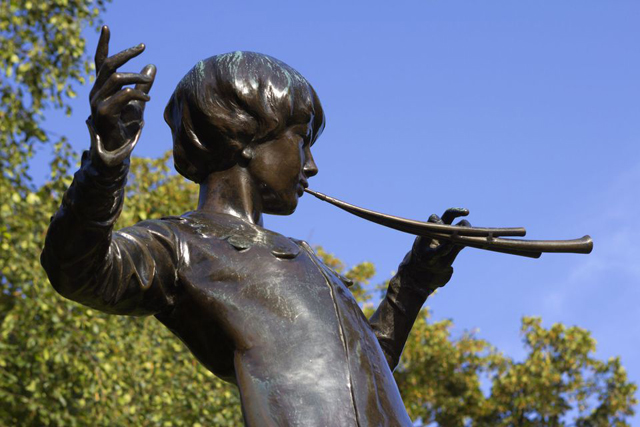
There are just some characters that were meant to soar across the silver screen. Naturally, one of them is well known for his power of flight. Since his debut on the London stage in 1904, Peter Pan has captured the imagination of audiences around the world. The boy who never grows up and whisks the Darling children off to an adventure in the magical realm of Neverland has remained almost perennially popular for over a century. Indeed, Peter Pan is timeless, and he continues to remain popular to this day. Created by author and playwright J.M. Barrie, Pan takes his inspiration from the ancient greek god of nature, and has become a symbol of youthful exuberance. He’s both an aspirational hero for young children and also a negative reference point for describing an immature adult. And for his entire existence, he has always belonged to the visual medium. Before the movies existed, the stage was the greatest venue for entertaining the masses, and Barrie’s masterwork was what in those days would have been considered a blockbuster. There was probably nothing more breathtaking at that time than seeing the performer playing Peter Pan (most likely a girl, especially in the early days) flying across the stage, supported by unseen wires. That act of onstage magic would continue to inspire audiences for many years, and carry over into the medium film. And as advances in cinematic techniques improve over time, the magic behind Peter Pan and the wonders of Neverland looks and feels more spectacular. It didn’t take long for Pan to work his way onto the silver screen, and his journey through cinema has remained a consistent one. You rarely see any of his cinematic adventures stray very far from Barrie’s original text. In many ways, the differences come less from the story, and more from what each performer brings to it. So, let’s take a look at some of the more notable cinematic interpretations of the boy who could fly, Peter Pan.

BETTY BRONSON from PETER PAN (1924)
There were several silent productions made with Peter Pan in the earliest days of cinema, but this Paramount Pictures production is the most noteworthy. The movie is pretty much a direct adaptation of Barrie’s play, carrying over many of the conventions from the stage. The lead role is played by a woman, in this case actress Betty Bronson. The actor in the role of the villainous Captain Hook does double duty, playing the role of Mr. Darling as well like in the play. There is even an actor still dressed in a dog suit playing the role of Nana, the Darling children’s pet canine. But, what separates this from the stage version is more substantial production values. The flying sequences have more weight to them, because for one thing the actors can fly higher and further on a sound stage than on theatrical one. Early processing effects also presented things that you could never do on the stage; like showing Tinker Bell for instance, who only appeared as a flashing light on stage before. Other than that, the movie still feels very close to it’s stage origins, which is particularly true about the titular character himself. Betty Bronson fits into the green tunic-ed hero perfectly, capturing the spunkiness of the character, as well as his strong willed determination. Anyone who had been familiar with the play in it’s early days would have been satisfied with her performance here. Though limited by the lack of sound from this period, Bronson still manages to convey the personality with a plenty of lively pantomime. She also works comfortably with all the visual effects that are on display, never once looking like she’s out of place. The movie represented the right kind of way to bring Peter Pan successfully to the silver screen, and it would remain influential for years to come.
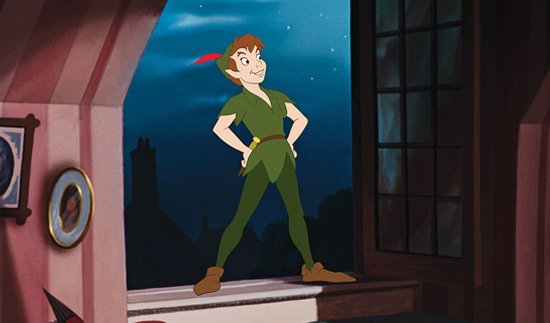
BOBBY DRISCOLL in WALT DISNEY’S PETER PAN (1953)
When we think of Peter Pan as a character, this is likely the first image that’ll pop into mind. Like many characters from classic literature, it’s the Disney version that ends up becoming the definitive take on the character, and rightly so in this case. Through animation, we are able to see the character leap fully out of his stagebound origins and take actual flight; no wires required. Peter Pan was pretty much destined to be an animated character, and thankfully Walt Disney did him justice. Disney himself believed very much in the character, recalling his early childhood days when he performed as Peter in a school play, with his brother Roy pulling the ropes backstage to help him fly. When Walt had his production slate firing up after the success of Snow White and the Seven Dwarves (1937), Peter Pan was a logical choice for development. The war years would delay it’s premiere by a decade, but once Disney returned to it, the movie solidly fell into place. Peter was animated by one of Walt’s trusted Nine Old Men, Milt Kahl, who brilliantly imagined the way Peter Pan takes flight; not so much soaring as floating in midair, something which only animation can convey. Also, in breaking from the stage tradition, Disney cast a boy in the role as opposed to the youthful actresses used in the stage productions. Bobby Driscoll, who had been a favorite child actor at the studio for films like Song of the South (1946) and So Dear to My Heart (1948), was just reaching that point where his voice was beginning to break, and it’s a perfect match for the youthful yet authoritative Peter. He’s a child, but one with responsibilities, which Driscoll captures perfectly in his spirited performance. The whole movie is probably the main reason why Peter Pan remains a popular character to this day, as it still holds up several generations later. Peter is still a fixture in the Disney canon, but even at the same time, it does so while still honoring the character J.M. Barrie created long before.
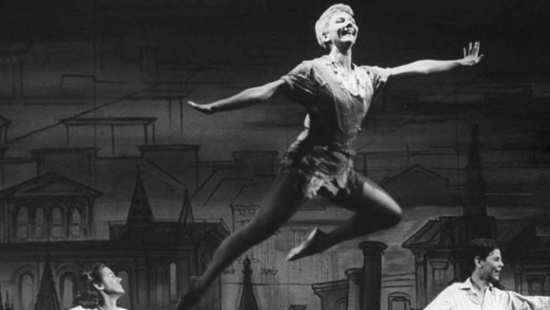
MARY MARTIN from PRODUCER’S SHOWCASE: PETER PAN (1955)
For the same generation that grew up with the Disney production, this was the other Peter Pan that defined the character. Famed Broadway director Jerome Robbins took the original Barrie play and added songs to it from famed lyricists Betty Comden and Adolph Green (of Singin’ in the Rain fame) and crafted this new musical adaptation. The musical became an instant Broadway hit, and catapulted it’s star, Mary Martin, into a household name. Because the Disney version was still fresh in people’s minds, it prevented a full movie version from getting the greenlight, but that helped to open the door for television as a result. The live broadcast series Producer’s Showcase, which helped to bring little seen stage productions to a mass audience, decided to bring Peter Pan onto their show in it’s entirety, complete with all the original cast members from the shows, including Martin who was still in the middle of her legendary stage run. The broadcast was also historic in that it was one of the first ever live broadcasts shot in color, despite color television not being available yet to the public. This would become useful in later re-broadcasts years later, but it represents an exceptional forward thinking idea on the producers part. The production values are pretty limited compared to other Pan adaptations, as unlike most others, this one is clearly stagebound, but it makes up for it with Mary Martin’s magnetic presence as Peter Pan. Her depiction of the character is rightly seen as one of the greatest ever. Just the way she spreads her arms and legs out as she flys around the stage just shows how much she is trying to convey a sense of weightlessness. Her role would remain a high-water mark for generations. Even the recent live tv version starring Allison Williams as Peter and Christopher Walken as Hook can’t quite capture the same exuberance that Martin brought to the role. It shows just how much a gifted performer can bring to a role.

ROBIN WILLIAMS in HOOK (1991)
The premise to this Spielberg directed fantasy is a fascinating one. What if Peter Pan did leave Neverland and grow up? What kind of person would he be? And the movie presents us with an interesting answer; he becomes an asshole lawyer who’s emotionally distant to his wife and kids. The first act of Hook is actually quite brilliant as it builds up this interesting story of a man having to confront the childhood he left behind, and find his way again, with Robin Williams delivering a strong performance as the grown up Peter Banning. And then, the movie beings to loose it’s way. I know many people love this movie, but for me, it falls apart after that strong opening. It’s happens when Peter makes it back to Neverland, and it’s this drab, ugly place. And from that point, all the promising magic drains out of the movie. Even when Robin Williams finally emerges in all his Peter Pan glory, it’s kind of a let down, because his buffoonish Pan is not as interesting as the character he had already been establishing himself as. I honestly get more out of the scenes with Hook and Smee, played brilliantly by Dustin Hoffman and a perfectly cast Bob Hoskins. Mostly, my disappointment with this movie says more about me with my transition into adulthood. I find that I like this movie less as I get older, because I see more of the flaws. The ugly production design probably is where the movie looses me the most, because I have this colorful view of Neverland in my mind, that no doubt was influenced by the Disney version. But also, I feel like having the normally rambunctious Robin Williams in the role of Peter Pan should have been a slam dunk, and yet he’s so much better when he’s not in his green tights. It’s not a good sign when Robin Williams gets upstaged by Rufio (played by Dante Basco), who yes is a standout, if somewhat cliched character. I hold it against no one if you like this movie, but to me, it’s a lesser depiction of Peter Pan and his story; even made more disappointing by what it could have been based on how it starts out.
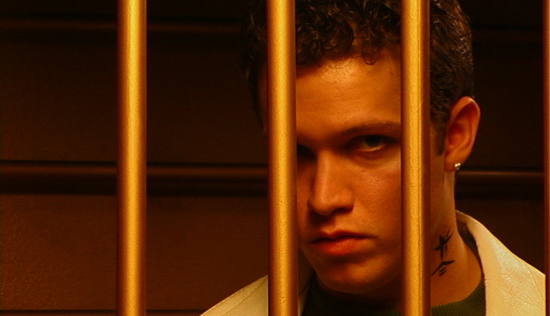
RICK SPARKS in NEVERLAND (2003)
Although Hook may have missed the mark in it’s story, there is another version that completely departs from Barrie’s tale entirely. Here we have a modern retelling of the story, stripping away the childhood wonderment of the the original story, and giving it a seedier, adult oriented makeover. This micro-budget, avante garde depiction from Queer Cinema auteur Damion Dietz reimagines the fantasy world of Neverland as a run down amusement park that attracts outsiders and social outcasts, like prostitutes, drug addicts, hustlers, and con artists. There’s a satirical point made in this somewhere, but it gets drowned out by the filmmakers grungy style. It’s no more apparent that the director cares little about the essence of Barrie’s original story than with his choices with regards to the character himself. Peter is very much a character of this world, in that he’s an immature man child, indulging in the dark depths of this Neverland. Actor Rick Sparks is fine in the role, but his character is far from likable. It’s definitely not a version of this story that is appropriate for all ages and should only be seen by the morbidly curious. But it does illustrate how the story can be adapted to a different place and time, and still remain familiar. But unless you want to see a coke snorting Tinker Bell and a BDSM obsessed Captain Hook, I’d say look elsewhere for a better version of this story.
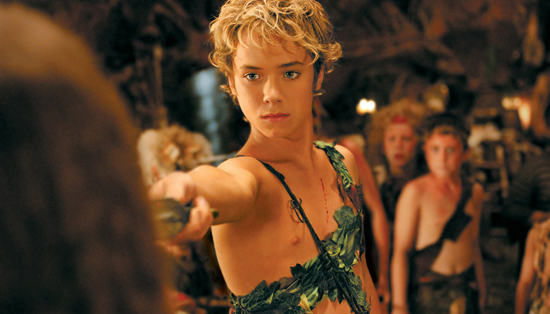
JEREMY SUMPTER in PETER PAN (2003)
Though Peter Pan has had a long history on the silver screen up to this point, it’s surprising that it took this long to actually get the character portrayed in live action as he’s written on the page. In this P. J. Hogan directed feature, we get a Peter who’s actually played by a young male actor, and not just in voice. A then pre-teen Jeremy Sumpter does look the part, though seeing an actor this young in a costume this skimpy is unsettling at times; evoking the idea of the wrong kind of Neverland. Sadly, he’s not given as much development as past versions of Peter, because despite what the title says, this isn’t his story. This movie actually focuses more on the character of Wendy Darling. It’s her journey into blossoming womanhood that fills out most of the movie’s runtime. Peter is more reduced to an ideal love interest for her, which I guess might explain the outfit. Sumpter is also overshadowed by an over-the-top performance from Jason Isaacs as Captain Hook. But given how little impact he has, Sumpter still gives Peter a presence. We see more of Peter’s cunning instincts in this version here; the kind of strong awareness that has allowed him to remain alive in a world where he’s constantly hunted by pirates. His playful side is there too, but the movie does a capable job of showing why he is so revered by both the Wendy and the Lost Boys. Though the movie itself is unfocused and scattershot, it does a fine job in portraying its central hero, and especially gives much more importance to the bond between him and Wendy.

LEVI MILLER in PAN (2015)
Now this is a strange one to be sure. At a time when classic family stories are constantly being rebooted, I’m surprised Disney was beaten to the finish line with this one. Although, it didn’t quite benefit studio Warner Brothers either. Pan was a costly flop for the studio, earning back only 20% of its original cost. Not only that, it put off a lot of audiences who were expecting a faithful adaptation of the story. Instead, it offers up an origin story as it were, with young Peter being kidnapped by pirates from a London orphanage and taken to a post-apocalyptic Neverland where he and his other “lost boys” are expected to work as slaves in a vast mine controlled by the power-hungry Captain Blackbeard (a very campy Hugh Jackman). Oh, and the slaves pass their time by singing Nirvana’s “Smells Like Team Spirit.” I am not kidding. There are many baffling cinematic choices like that one in the movie, and it’s surprising that a quality director like Joe Wright (Atonement) was behind this mess. For me, the movie is to the point where it’s so weird that it becomes fascinating to watch, like a guilty pleasure. But oddly enough, the one thing that is not interesting in it’s weirdness is Peter himself. Levi Miller unfortunately is a little boring in the role, somewhat lost in all the movie’s insanity. He’s age appropriate enough, but the movie seems less interested in his character than it is about his world, and it becomes clear that he’s just there to fill out a role rather than be the character. There is little else to indicate that this young kid is going to become the character we all know. It pretty much just sets up the origin story tropes, while at the same time forgetting to make it’s hero all that interesting.
So, it’s been an up and down journey for Peter Pan as a character on the silver screen. In many ways, the character has kind of been lost in more recent years, as many filmmakers have needlessly tried to adapt the story to more modern sensibilities. And it really is unnecessary because the character is at his very core timeless. The Disney classic proves this, as it still remains a popular film almost 7 decades later, and as a stage production, the story has changed very little from J.M. Barrie’s original text. There really is no need to do a deconstruction of the whole narrative. As a character, Peter Pan remains very relevant. He still inspires the adventurous side in most younger audiences, while also making older viewers reflective of their own childhood ideals, and how they’ve changed as they’ve gotten older. It’s something that at one point the movie Hook was building an intriguing narrative towards, until it gets undone by the films spectacle and unfocused execution. Still, Peter remains popular and its because he’s a character that remains constant through all generations. Though we may grow old, he remains the same youthful spirit that stays as a part of lives, no matter who fills out the role. I myself still consider him one of my favorite characters, and may or may not have dressed up for Halloween as the character when I was still a kid (green tights and all). Think happy thoughts, and let’s all continue to fly to Neverland with Peter Pan.